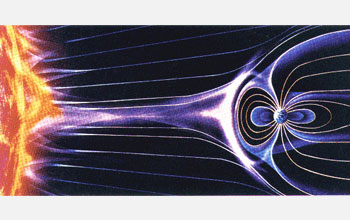Underwater Vibrations
 |
| VIVACE System generates electricity from slow-flowing water |
One of the oldest forms of energy used the flow of water to spin wheels. This is still used today in large rivers to generate electricity. This method only works in rapid water, but a new method being studied by researchers at Vortex Hydro Energy could be used to gather energy in any type of water, whether its moving or not. The theory is that even the slowest moving water produces significant turbulence when it passes around an obstacle. The researchers produced a system that allows a series magnets to bob in the turbulence and charge wires.
According to Vortex Hydro Energy, this system can be used in almost any location, whether is is in a river, lake, or ocean. Another benefit of the system is that unlike dams it doesn't interfere with the local ecosystems. There are no spinning components that are hazardous to fish and other marine life, and since it is only on the waterbed it doesn't limit the migration of fish like dams do.
The design is currently still being tested, but with three open water test already under its belt, the system, titled the VIVACE, could be powering marinas and other shoreline buildings within the next few years.
Click here for more information on the new underwater generator
Fuel Producing Bacteria
 |
| Researchers monitoring fuel producing bacteria |
Researchers in Sweden are also looking to the ocean for energy solutions. However, they are not looking at the water at all, they are looking at the algae, or more specifically, the bacteria that grows on the algae. Researchers at the KTH Royal Institute of Technology in Stockholm have discovered that by genetically modifying cyanobacteria, which is found on algae, they can make it efficiently produce butanol, which could act as a substitute for ethanol.
 |
| Close-up view of cyanobacteria |
While ethanol is very unpredictable because the price of corn is very unstable, all that is needed to produce butanol is sunlight, CO2, and seawater. Because of this, when butanol goes into large scale production it will be cheaper and the price will be much more stable.
Current research on the cyanobacteria is still in preliminary stages. Researchers still need to determine how they can make sure that the bacteria will survive while producing so much butanol. After that, researchers must modify more genes until they develop a bacteria that can produce longer chains of hydrocarbons, which are more similar to gasoline, and that can survive outside the laboratory.
Click here for more information on the genetically engineered cyanobacteria
Solar Wind
 |
| Diagram of solar wind bending around Earth |
While the sun has been a potential source of energy for many years, recently scientists have discovered that the charged particles released by the sun, called solar wind, could be used to generate much more power than traditional solar power. Researchers at Washington State University have concluded that a large sail placed between the earth and the sun could produce very large amounts of energy.
According to the team at WSU:
300 meters (984 feet) of copper wire, attached to a two-meter-wide (6.6-foot-wide) receiver and a 10-meter (32.8-foot) sail, would generate enough power for 1,000 homes.That is 100 billion times the energy we currently use. While an ambitious project like that would be ambitious, a scaled project that produced a more reasonable amount of electricity would be possible with modern electricity.
A satellite with a 1,000-meter (3,280-foot) cable and a sail 8,400 kilometers (5,220 miles) across, placed at roughly the same orbit, would generate one billion billion gigawatts of power.
The problem for the researchers isn't in capturing the energy, but in transmitting it back to earth. As of now, there are no methods that can efficiently transport energy that distance without the use of a carrier like a battery. A medium sized solar sail could be ready to generate electricity could be ready in a few years, but the technology it would take to transmit the energy back to Earth could take decades to figure out
Click here for more information on generating energy from solar wind
This is the third part in a four part Inspiring Technology series on the future of energy. Please keep a look out for the final section, which will come out this Monday. If you have any questions or insights feel free to comment below. If you want to keep an eye on our posts, feel free to subscribe to our email newsletter or RSS feed. Also, make sure you find us on Facebook and twitter.

No comments:
Post a Comment